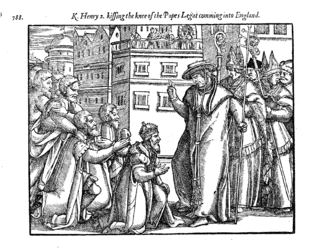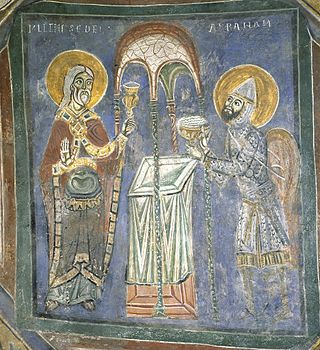
Pope Boniface VIII was the head of the Catholic Church and ruler of the Papal States from 24 December 1294 to his death in 1303. The Caetani family was of baronial origin, with connections to the papacy. He succeeded Pope Celestine V, who had abdicated from the papal throne. Boniface spent his early career abroad in diplomatic roles.

Pope Gregory IX was head of the Catholic Church and ruler of the Papal States from 19 March 1227 until his death in 1241. He is known for issuing the Decretales and instituting the Papal Inquisition, in response to the failures of the episcopal inquisitions established during the time of Pope Lucius III, by means of the papal bull Ad abolendam, issued in 1184.

Pope Innocent IV, born Sinibaldo Fieschi, was head of the Catholic Church and ruler of the Papal States from 25 June 1243 to his death in 1254.

Anagni is an ancient town and comune in the province of Frosinone, Latium, central Italy, in the hills east-southeast of Rome. It is a historical and artistic center of the Latin Valley.

A papal legate or apostolic legate is a personal representative of the Pope to foreign nations, to some part other of the Catholic Church, or representatives of the state or monarchy. He is empowered on matters of Catholic faith and for the settlement of ecclesiastical matters.

The Treaty of San Germano was signed on 23 July 1230 at San Germano, present-day Cassino, ending the War of the Keys that had begun in 1228. The parties were Pope Gregory IX and Frederick II, king of Sicily and Holy Roman emperor. On 28 August at Ceprano, the peace was finalized with the readmission of the excommunicated Frederick into the church.
John Halgren of Abbeville was a French scholastic theologian and cleric. He served successively as a university professor, priest, prior, archbishop, cardinal, apostolic legate and diplomat.
Stephen (I) Báncsa was the first Hungarian cardinal of the Roman Catholic Church. Prior to that, he served as Bishop of Vác from 1240 or 1241 to 1243, then Archbishop of Esztergom from 1242 until his creation as cardinal.
Robert Capellanus, was a chaplain of King William I of Scotland and afterwards, Bishop of Ross (1214–1249).
The 1241 papal election saw the election of Cardinal Goffredo da Castiglione as Pope Celestine IV. The election took place during the first of many protracted sede vacantes of the Middle Ages, and like many of them was characterized by disputes between popes and the Holy Roman Emperor. Specifically, the election took place during the war between Frederick II, Holy Roman Emperor and the Lombard League and deceased pontiff, Pope Gregory IX, with Italy divided between pro-Papal and pro-Imperial factions known as the Guelphs and Ghibellines.
Niccolo Conti di Segni - Italian cardinal allegedly created by Pope Gregory IX with the title of San Marcello in the consistory of December 1228 and subsequently sent as papal legate to Armenia to mediate in the conflicts between king Hethum I of Armenia and the Principality of Antioch; king Hethum I considered him partial in favor of the Principality of Antioch and asked pope for his recalling. He is said to have died in 1239.

Perugia was a long-time papal residence during the 13th century. Five popes were elected here: Pope Honorius III (1216–1227), Pope Clement IV (1265–1268), Pope Honorius IV (1285–1287), Pope Celestine V (1294), and Pope Clement V (1305–1314). These elections took place in the Palazzo delle Canoniche adjoining the Perugia Cathedral.

The Palace of the Popes in Anagni, sometimes called the Boniface VIII Palace (Palazzo Bonifacio VIII), is a building in the ancient hill town of Anagni in central Italy, in the hills east-southeast of Rome. It is closely associated in history with Pope Boniface VIII, was later bought by his nephew Peter II Caetani, and now houses a museum named after the Pope. It is at present part of a property owned by the Cistercian Sisters of Charity and used in part as their motherhouse.

Thomas of Capua, also called Tommaso di Eboli, was an Italian prelate and diplomat. He served as the archbishop-elect of Naples from 1215 until 1216 and then as a cardinal until his death. He administered the diocese of Albano between 1218 and 1222 and was the papal legate in the kingdom of Italy from November 1236 until October 1237. He was the most important of Pope Gregory IX's negotiators with the Emperor Frederick II between 1227 and 1237.
Saxo de Anagnia was a Roman Catholic Cardinal, and Cardinal-priest of the titulus of S. Stefano al Monte Celio in Rome. He was a native of Anagni, and a member of the family of the Conti di Anagni. Dumas points out that there is no positive evidence of the family connection.

The War of the Keys (1228–1230) was the first military conflict between Frederick II, Holy Roman Emperor, and the Papacy. Fighting took place in central and southern Italy. The Papacy made strong gains at first, securing the Papal States and invading the Kingdom of Sicily, while Frederick was away on the Sixth Crusade. Upon his return, he defeated the papal forces, forcing Pope Gregory IX to begin peace talks. After drawn-out negotiations, the treaty of San Germano terminated the conflict with no territorial changes.

Pandulf of Anagni was an Italian cleric and military commander who became the bishop of Anagni in 1237. He came from a prominent family closely connected to a series of popes. In papal service, he led an army into the Kingdom of Sicily during the War of the Keys in 1229. As bishop, he commissioned the frescoes in the cathedral of Anagni.
Berthold of Urslingen was a German nobleman whose career was spent almost entirely in central Italy, where his family had a claim to the duchy of Spoleto.
Enrico da Settala, sometimes anglicized Henry of Settala, was the archbishop of Milan from 1213 until his death.

Berard of Castagna was a prelate and diplomat of the Kingdom of Sicily, who served as the archbishop of Bari (1207–1213) and archbishop of Palermo (1213–1252). Throughout his career he was a close ally of King Frederick II, who was also Holy Roman Emperor after 1220. He played a prominent role in the Sixth Crusade, both in the diplomatic preliminaries and in Frederick's visit to Jerusalem.